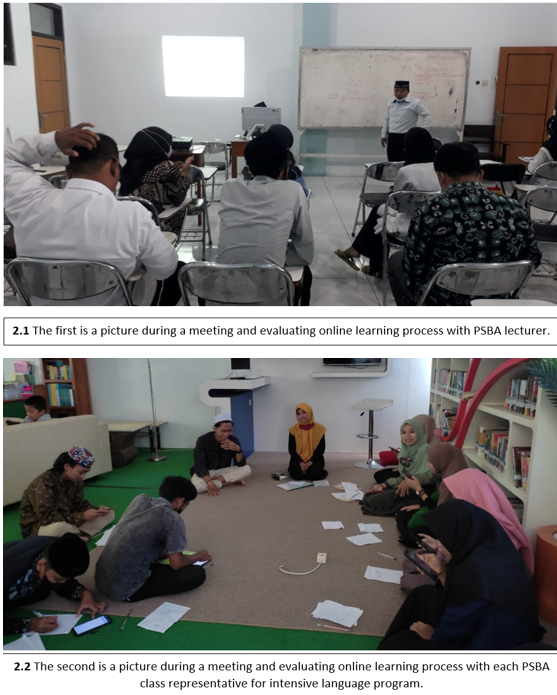" I didn't need to be shy; I participated in the class": A case study of WTC learning support among university students in a remote area
DOI:
https://doi.org/10.21070/jees.v7i1.1644Keywords:
Remote area, WTC, University studentsAbstract
In language classrooms all around the world educators contest to get students to address in the target language (Yashima, 2018). Educators in University level are steadily attempting new methodology to enhance students with WTC to efficiently speak during teaching-learning process. This qualitative study was designed to investigate the link between students' Willingness to Communicate (WTC) English via Mobile Assisted Language Learning (MALL)by the media supporting devices used in online learning. To gain the data, some interviews to ten lecturers and seven students’ participant have been conducted. the finding revealed that media supporting devices in online learning relate to students' WTC English via MALL such as (a) teaching-learning media flexibility, (b) teaching-learning media clarity, (c) teaching-learning classroom sequence formality, (d) teaching-learning media consistency, then (e) techno pedagogical discernment over lecturers and students. This study necessitates that heightening the WTC teaching-learning capacity via MALL through mobile devices extends substantial learning assistance, predominantly in the concept of efficiency for online classroom activities in real-time concurrences.
HIGHLIGHTS:
- The importance of media supporting factors, including media flexibility, media clarity, formality of class sequence, class consistency, and techno-pedagogical wisdom for lecturers and students.
- The impact of students' access and proficiency with media support tools on their engagement and success in online learning.
- Well-equipped students, who have access to devices like laptops or notebooks, are better prepared to use platforms like Zoom and Google Meet. In contrast, students with limited media tools find platforms such as WhatsApp and YouTube more accessible. This study highlights the influence of economic background on students' access to technology and the subsequent impact on their choice of online communication tools.
Downloads
References
Cao, Y., & Philip, J. (2006). Interactional context and willingness to communicate: a comparison of behaviour in whole class, group and dyadic interaction. System, 34, 480–493.DOI: 10.1016/j.system.2006.05.002
Chu, H.-C., Hwang, G.-J., Tsai, C.-C., & Tseng, J. C. R. (2010). A two-tier test approach to developing location-aware mobile learning systems for natural science courses. Computers & Education, 55(4),
–1627. https://doi.org/10.1016/J.COMPEDU.2010.07.004
Creswell, J. W. (2012). Educational research: Planning, conducting, and
evaluating quantitative and qualitative research (4th ed.). Pearson.
Creswell, J. W. (2013). Qualitative inquiry and research
design:Choosing among five approaches (3rd ed). SAGE Publications.
Elliott, J. (2005). Using Narrative in Social Research: Qualitative and Quantitative Research. SAGE. https://doi.org/10.4135/9780857020246
Facer, K. (2004). Foreword to the literature in mobile technologies and learning, in:(Eds) L. Naismith, P. Lonsdale, G. Vavoula& M. Sharples Future lab report
http://www.futurelab.org.uk/resources/documents/
lit_reviews/Mobile_Review.pdf.
Fallahkhair, S., Pemberton, L. & Griffiths, R. (2007).
Development of a cross-platform ubiquitous language learning service via cell phone and interactive television.Journal of Computer Assisted Learning,
(4), 312-325. https://doi.org/10.1111/j.13652729.2007.00236.x
Halupka-Rešetar, S., Knežević, L., &Topalov, J. (2018).
Revisiting willingness to communicate in English has a foreign language: The Serbian perspective. Journal of Multilingual and Multicultural Development, 39(10), 912–924.
https://doi.org/10.1080/01434632.2018.1454456
Hasanah, S., & Pradipta, P. (2021). Low-tech MALL for EFL intensive class among university students in remote areas. JEES (Journal of English Educators Society), 6(1), 116-125. DOI: https://doi.org/10.21070/jees.v6i1.1090
Hennebry-Leung, M., & Xiao, H. A. (2020). Examining the role of the learner and the teacherin language learning motivation. Language Teaching Research. DOI: https://doi.org/10.1177/1362168820938810
Jati, A. F., Fauziati, E., &Wijayanto, A. (2019). Why do the students do disruptive behaviour in English classroom? A case study on senior high school students in one of the small towns in Indonesia. International Journal of Language Teaching and Education, 3(2), 130–141. https://doi.org/10.22437/ijolte.v3i2.7701
Jiang, N. (2007). Selective integration of linguistic knowledge in adult second language learning. Language Learning, 57(1), 1-33. DOI: 10.1111/j.1467-9922.2007.00397.x
Johnson, B., & Christensen, L. (2014). Educational research: Quantitative, qualitative, and mixed approaches (5th ed.). Sage Publications, Inc.
Kukulska-Hulme, A., Traxler, J. & Pettit, J. (2007).
Designed and user-generated activity in the mobile age, Journal of Learning Design, 2(1), 52-65. DOI:10.5204/jld.v2i1.28
Lee, J. S., Sylvén, L. K., & Lee, K. (2020). Cross-cultural insights into Korean and Swedish secondary school students’ willingness to communicate in a second language. Journal of Multilingual &Multicultural Development, 41, 115.DOI:https://doi.org/10.1080/01434632.2019.1708917
Lee, J. S., Lee, K., & Chen Hsieh, J. (2019). Understanding
willingness to communicate in L2 between Korean and Taiwanese students. Language Teaching Research. DOI: https://doi.org/10.1177/1362168819890825
Miangah, T. M and Nezarat, A. (2012). Mobile Assisted Language Learning. International Journal of Distributed and Parallel System (IJDP). 3(1). DOI:10.5121/ijdps.2012.3126
Miles, M. B.s, Huberman, A. M., & Saldana, J. (2013).
Qualitative Data Analysis: A Method Sourcebook (3rd ed.). Arizona State University.
O’Donoghue, T. A., & Punch, K. F. (2003). Qualitative Educational Research in Action: Doing and Reflecting. Routledge.https://doi.org/10.4324/9780203506301
Pawlak, M., Mystkowska-Wiertelak, A., &Bielak, J. (2016).
Investigating the nature of classroom willingness to communicate (WTC): A micro-perspective. Language Teaching Research, 20(5), 654–671.https://doi.org/10.1177/1362168815609615
Pradipta, P. (2020). Basic interpersonal communicative skill among students in junior high school. Language-Edu.
(2). http://riset.unisma.ac.id/index.php/LANG/article/view/7349
Peng, J.-E., & Woodrow, L. (2010). Willingness to communicate in English: A model in the Chinese EFL classroom context: Willingness to communicate in English. Language Learning, 60(4), 834–876.
DOI: https://doi.org/10.1111/j.1467-9922.2010.00576.x
Salam, N., Ubaidillah, M. F., & Putri, A. N. (2021).
Indonesian ESP Students’ Willingness to Communicate in English: Focusing on Situated Factors. The Journal of Asia TEFL, 18(1), 336-344. DOI: http://dx.doi.org/10.18823/asiatefl.2021.18.1.25.336
Sharples. M. (2006). The design of personal mobile technologies for lifelong learning. Computers & Education, 34(3-4), pp. 177-193. DOI:10.1016/S0360-1315(99)00044-5
Trifanova, A., Knapp, J., Ronchetti, M., &Gamper, J. (2004).
Mobile ELDIT: Challenges in the transitions from an e-learning to an m-learning system. Trento, Italy: University of Trento. http://eprints.biblio.unitn.it/archive/00000532/01/pap er4911.pdf.
Yashima, T., MacIntyre, P. D., & Ikeda, M. (2018). Situated willingness to communicate in an L2: Interplay of individual characteristics and context. Language Teaching Research, 22(1), 115-
https://doi.org/10.1177%2F1362168816657851
Zeng, M., (2010). Chinese students’ willingness to communicate in English in Canada (Doctoral dissertation). Windsor, Ontario: Canada. https://scholar.uwindsor.ca/cgi/viewcontent.cgi?articl e=9031&context=etd

Published
How to Cite
Issue
Section
License
Copyright (c) 2022 Shofiyatul Hasanah, Parahita Pradipta, Erfan Efendi

This work is licensed under a Creative Commons Attribution 4.0 International License.







